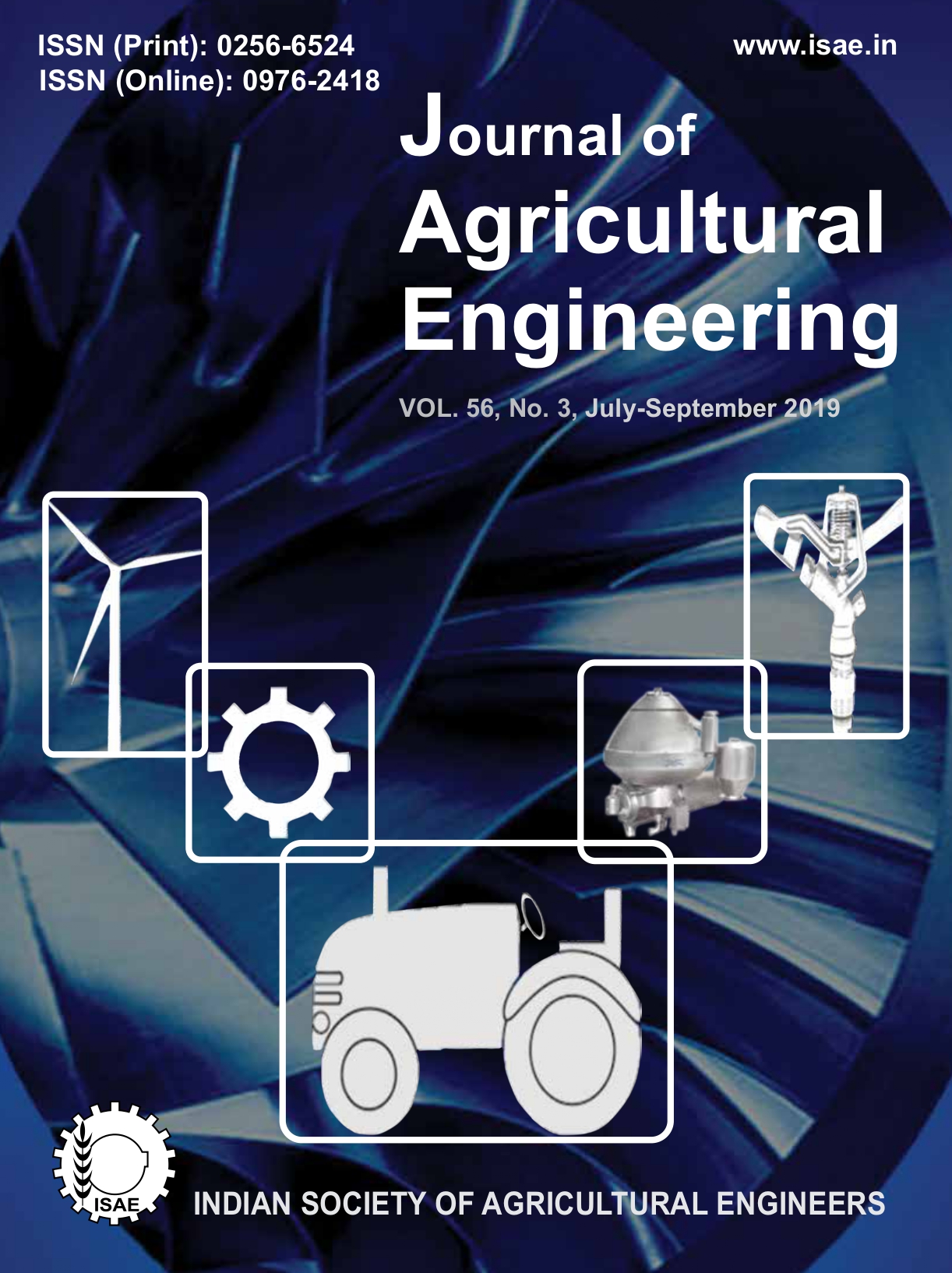Rapid Detection of Live and Dead Escherichia coli in a Suspension Using Spectroscopy and Chemometrics
DOI:
https://doi.org/10.52151/jae2019563.1690Keywords:
Classification, principal component analyses, SIMCA, UV-Vis spectroscopy, wavelength rangeAbstract
Viability assessment of bacteria is critical in monitoring of food or environmental samples. Existing methods are time-consuming, labour-intensive or require trained manpower and costly chemicals. Potential of commonly used UV-visual spectrometer was explored for rapid viability detection of Escherichia coli (ATCC 8739). Spectra of samples (live and dead cells) mixed in different proportion revealed clear differences. Live bacterial suspension showed absorption peak at 260 nm with decreasing amplitude as the proportion of live bacteria was reduced in the suspension and vice-versa. Principal component analyses (PCA) of spectral data showed clear clustering of samples based on the level of live bacterial cells (5 % significance level). Soft Independent Modelling of Class Analogy (SIMCA) and Partial Least Square Discriminant Analysis (PLSDA) yielded 100 % correct classification with test samples. The percentage of live and dead bacteria in a suspension could be predicted with coefficient of determination (R2 ) of 0.980 and 0.977 for calibration and validation sample sets, respectively, in the range of 259-261 nm using Multiple Linear Regression (MLR). Low standard errors of calibration (4.5), prediction (4.8) and high R2 (0.98) indicated the potential of UV visual spectrometer to detect and predict live and dead cells of E. coli in a suspension.
References
Ahmed O B; Asghar A H; Elhassan M M. 2014. Comparison of three DNA extraction methods for polymerase chain reaction (PCR) analysis of bacterial genomic DNA. Afr. J. Microbiol., 8(6), 598-602.
Alupoaei C E; García-Rubio L H. 2005. An interpretation model for the uv-vis spectra of microorganisms. Chem. Eng. Commun.,192, 198–218.
Auty M A E; Gardiner G E; Mcbrearty S J; O’sullivan E O; Mulvihill D M; Collins J K; Fitzgerald G F; Stanton C; Ross R P. 2001. Direct in situ viability assessment of bacteria in probiotic dairy products using viability staining in conjunction with confocal scanning laser microscopy. Appl. Environ. Microbiol., 67, 420–425.
Barbosa J; Costa-de-Oliveira S; Rodrigues A G; Pina-Vaz C. 2008. Optimization of a flow cytometry protocol for detection and viability assessment of Giardia lamblia. Trav. Med. Infect. Dis.,6, 234-239.
Besaratinia A; Yoon J; Schroeder C; Bradforth S E; Cockburn M; Pfeifer G P. 2011. Wavelength dependence of ultraviolet radiation-induced DNA damage as determined by laser irradiation suggests that cyclobutane pyrimidine dimers are the principal DNA lesions produced by terrestrial sunlight. J. Fed. Am. Soc. Exp. Biol., 25(9), 3079-3091.
Bolton J R; Cotton C A. 2008. Ultraviolet Disinfection Handbook. American Water Works Association, Denver, CO, USA, 1-149.
Brehm-Stecher B F; Johnson E A. 2004. Single-cell microbiology: tools, technologies, and applications. Microbiol. Mol. Biol. Rev., 68, 538–559.
Davis R; Deering A; Burgula Y; Mauer L J; ReuhsB L. 2011. Differentiation of live, dead and treated cells of Escherichia coli O157:H7 using FT-IR spectroscopy. J. Appl. Microbiol., 112, 743-751.
Devatkal S K; Jaiswal P; Kaur A; Juneja V. 2015. Inactivation of Bacillus cereus and Salmonella enterica serovar typhimurium by aqueous Ozone: Modeling and UV-Vis spectroscopic analysis. Ozone: Sci. Eng., 38(2), 124-132.
Dunn W J; Wold S. 1995. SIMCA pattern recognition classification In: Chemometric methods, Molecular Design.( Ed.Van De Waterbeemd H.), VCH Publishers, New York, 179-193.
Grewal M K; Jaiswal P; Jha S N. 2014. Detection of poultry meat specific bacteria using FTIR spectroscopy and chemometrics. J. Food Sci. Technol., 52(6), 3859- 3869.
Jaiswal P; Jha S N; Kaur J; Borah A; Ramya H G. 2018. Detection of aflatoxin M1 in milk using spectroscopy and multivariate analyses. Food Chem., 238, 209-214.
Kowalski W. 2009. Ultraviolet Germicidal Irradiation Handbook. UVGI for Air Surface Disinfection, Springer, Verlag Berlin Heidelberg, 1- 493.
Makino S I; Kii T; Asakura H; Shirahata T; Ikeda T; Takeshi K; Itoh K. 2000. Does enterohemorrhagic Escherichia coli O157:H7 enter the viable but nonculturable state in salted salmon roe. Appl. Environ. Microbiol., 6b, 5536–5539.
Nkere C K; Ibe N I; Iroegbu C U. 2011. Bacteriological quality of foods and water sold by vendors and in restaurants in Nsukka, Enugu State, Nigeria: A comparative study of three microbiological methods. J. Health Popul. Nutr., 29, 560-566.
Nocker A; Camper A K. 2009. Novel approaches toward preferential detection of viable cells using nucleic acid amplification techniques. FEMS Microbiol. Lett., 291, 137-142.
Park C W; Yoon K Y; Byeon J H; Kim K; Hwang J. 2012. Development of rapid assessment method to determine bacterial viability based on ultraviolet and visible (UV-Vis) spectroscopy analysis including application to bioaerosols. Aerosol Air Qual. Res., 2, 399-408.
Prescott M L; Harley P J; Klein A D. 2005. Microbiology. 6th ed. McGraw Hill, Singapore, pp: 1222.
Robertson J; McGoverin C; Vanholsbeeck F; Swift S. 2019. Optimisation of the protocol for the live/deadr baclighttm bacterial viability kit for rapid determination of bacterial load. Frontiers Microbiol.. doi: 10.3389/fmicb.2019.00801
Seshadri S; Han T; Krumins V; Fennell D E; Mainelis G. 2009. Application of ATP bioluminescence method to characterize performance of bioaerosol sampling devices. J. Aerosol. Sci., 40, 113–121.
Soejima T; Schlitt-Dittrich F; Yoshida S. 2011. Rapid detection of viable bacteria by nested polymerase chain reaction via long DNA amplification after ethidium monoazide treatment. Anal. Biochem., 418, 286–294.
Varma J K; Greene K D; Reller M E; DeLong S M; Trottier J; Nowicki S F; Diorio M; Koch E M; Bannerman T L; York S T; Lambert-Fair M A; Wells J G M; Mead P S. 2003. An outbreak of Escherichia coli O157 infection following exposure to a contaminated building. J. Am. Med. Assoc., 290, 2709–2712.
VladisavljevićG T; Surh J; McClements J D. 2006. Effect of emulsifier type on droplet disruption in repeated Shirasu porous glass membrane homogenization. Langmuir, 22(10), 4526-4533.
Wilks S A; Michels H; Keevil C W. 2005. The survival of Escherichia coli O157 on a range of metal surfaces. Int. J. Food Microbiol., 105, 445–454.
Yang Z; Zhang X P; Lv B. 2014. Classifications of decorative paper using differential reflection spectrophotometry coupled with soft independent modelling of class analogy. Bio Resour., 9, 2521-2528.














